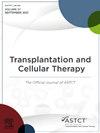Prospective Assessment of Quality of Life and Patient-Reported Toxicities Over the First Year After Chimeric Antigen Receptor T-Cell Therapy
IF 3.6
3区 医学
Q2 HEMATOLOGY
引用次数: 0
Abstract
Chimeric antigen receptor (CAR) T-cell therapy has transformed survival outcomes in patients with relapsed and refractory large B-cell lymphoma (LBCL), but it is associated with a variety of side effects. This study examined changes in patient-reported quality of life (QoL) and toxicities, as well as risk factors for worse QoL and toxicities, in the first year after treatment. Patients with LBCL completed questionnaires assessing QoL and toxicity severity before infusion, and 90, 180, and 360 days after infusion. Mixed models were used to examine changes in QoL and toxicities over time, and clinical moderators of change in QoL and toxicities. Patients reported improvements in physical functioning and fatigue in the year after treatment (P values <.01), but there were no changes in pain, anxiety, or depression over time. Patients with active disease at day 90 reported more physical dysfunction at all postinfusion timepoints (Ps ≤ .01) compared to patients who responded to treatment. Similarly, patients with active disease at day 90 reported worsening depression over time, such that at day 360, depressive symptoms were worse for patients with active disease than patients without active disease (P = .02). Patients treated with 4+ lines of prior therapy reported worsening pain and anxiety over time, such that at day 360, both pain and anxiety were significantly worse for patients previously treated with 4 of more lines of therapy than patients treated with fewer lines of therapy (Ps ≤ .01). Regarding toxicities, patients reported decreasing overall toxicity burden up to day 180, with subsequent worsening at day 360 (P = .02). Most patients reported at least one or two grade 2 toxicities at each timepoint. Patients demonstrated unchanging or improved QoL after treatment with CAR T-cell therapy, but active disease and greater prior lines of therapy were associated with worse QoL outcomes over time. Toxicity severity also improved during the first 6 months post-treatment, but worsened thereafter, particularly among patients with active disease after treatment.
对 CAR T 细胞疗法后第一年的生活质量和患者报告的毒性进行前瞻性评估。
背景嵌合抗原受体(CAR)T细胞疗法改变了复发和难治性大B细胞淋巴瘤患者的生存结果,但它也与各种副作用有关 目标: :本研究调查了治疗后第一年患者报告的生活质量(QoL)和毒性的变化,以及导致生活质量和毒性恶化的风险因素:大B细胞淋巴瘤患者在输液前、输液后90天、180天和360天填写问卷,评估生活质量和毒性严重程度。采用混合模型研究随时间变化的生活质量和毒性变化,以及生活质量和毒性变化的临床调节因素 结果:............:治疗后一年内,患者的身体机能和疲劳感均有所改善(P值
本文章由计算机程序翻译,如有差异,请以英文原文为准。
求助全文
约1分钟内获得全文
求助全文
来源期刊

Transplantation and Cellular Therapy
Medicine-Hematology
CiteScore
7.00
自引率
15.60%
发文量
1061
审稿时长
51 days
 求助内容:
求助内容: 应助结果提醒方式:
应助结果提醒方式:


